CI/CD pipeline has gradually become a pillar of success in achieving sustainable delivery of bug-free code at high velocity. After all, customers love momentum! Month-long software release cycles belong to the bygone era for good. No wonder enterprises are giving their all to build a scalable CI/CD pipeline that benefits developers, end-users, and the business as a whole.
However, its efficiency depends heavily on automation. And that’s why it is essential to select the best CI/CD tools that enable meaningful and effective implementation of continuous integration and continuous delivery throughout the software delivery cycle.
Read the article to know the basics, essential stages, attributes, and examples of a properly configured CI/CD pipeline that ultimately leads to a faster and more agile development life cycle.
Let’s first understand how CI/CD improves the workflow by bridging the gaps between development and operation activities and integrating automation in various stages of software development.
What is a CI/CD pipeline?
CI/CD pipeline is a cornerstone of the DevOps approach, a series of orchestrated steps that drives software development by building codes, running tests, and deploying new software versions into all necessary environments.
The ultimate goal of the CI/CD pipeline is to minimize human errors and have a consistent software release by automating repetitive processes. By automating various phases of the CI/CD pipeline, development teams can work faster and improve software quality and other DevOps metrics. Here are some basic facts about the CI/CD pipeline:
- Software pipelines are mostly customized to suit the particular needs of the project and the business.
- Various types of tools for binary creation, code compilation, unit tests, code analysis, and security can be included in the pipeline.
- Containerized environments automate the packaging of the code into a container image that can be deployed across a hybrid cloud.
- Multiple pipelines are often required to take source code into production based on organizational and team structures.
- A CI/CD pipeline can be triggered by an event, like a code change (pull request), having a new artifact in an artifact repository, or some defined schedule to match a release cadence.
4 essential stages of a CI/CD pipeline
A CI/CD pipeline generally has several scripts that require execution in a specific order to achieve a common goal. Code – submitted at the start of the pipeline, passes through a series of stages inside the pipeline, and then gets published as production-ready code.
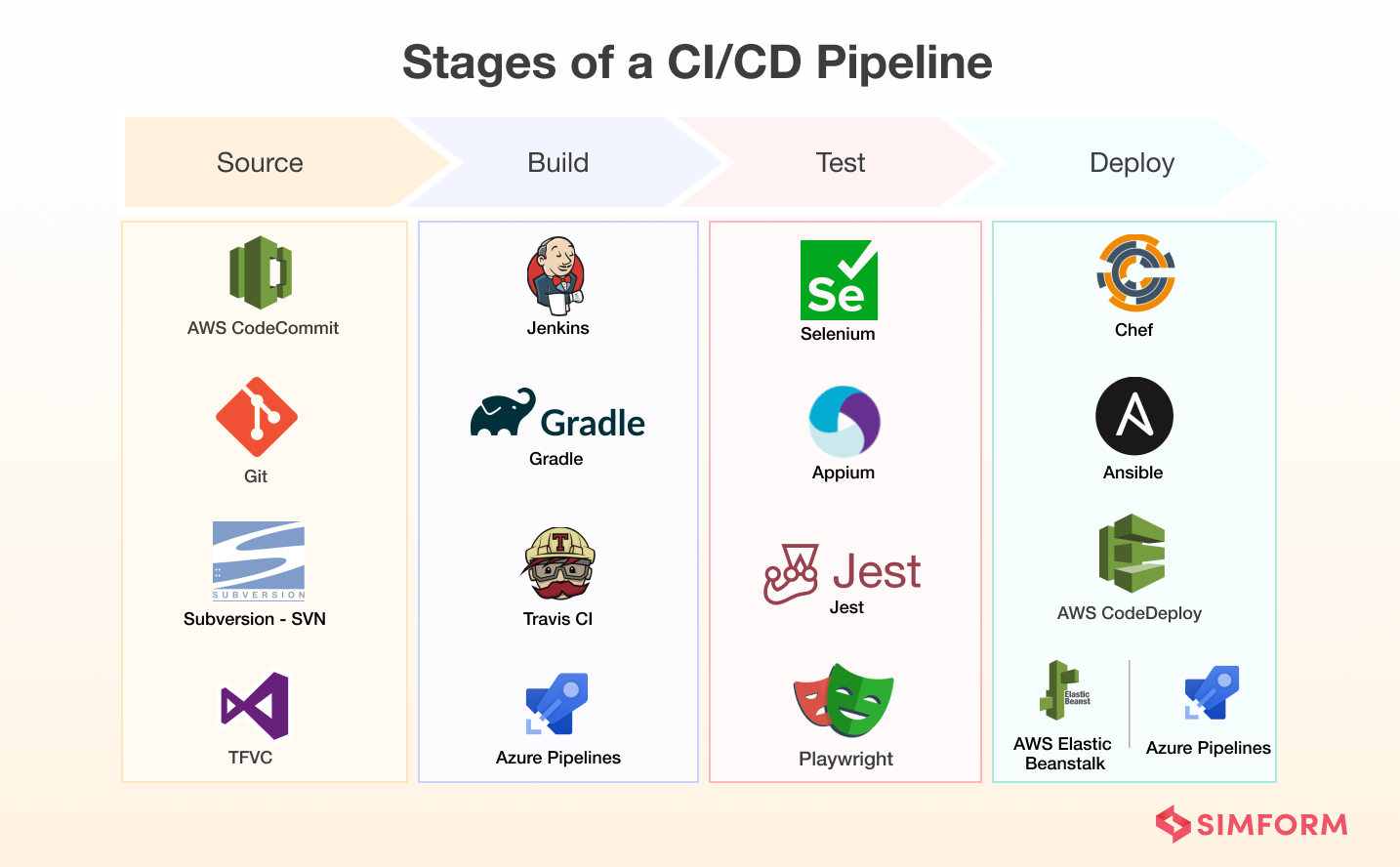
Generally, the CI/CD pipeline has four significant stages – source, build, test, and deploy. Each phase follows proper standards, well-detailed processes, and specific tools. Let’s explore these stages one by one.
Source
In this first stage, developers translate requirements into functional algorithms, features, and behaviors. Any change in a preconfigured flag in the code repository or the program triggers the CI/CD pipeline. Other common triggers are – user-initiated or automatically scheduled workflow, results of other pipelines, etc.
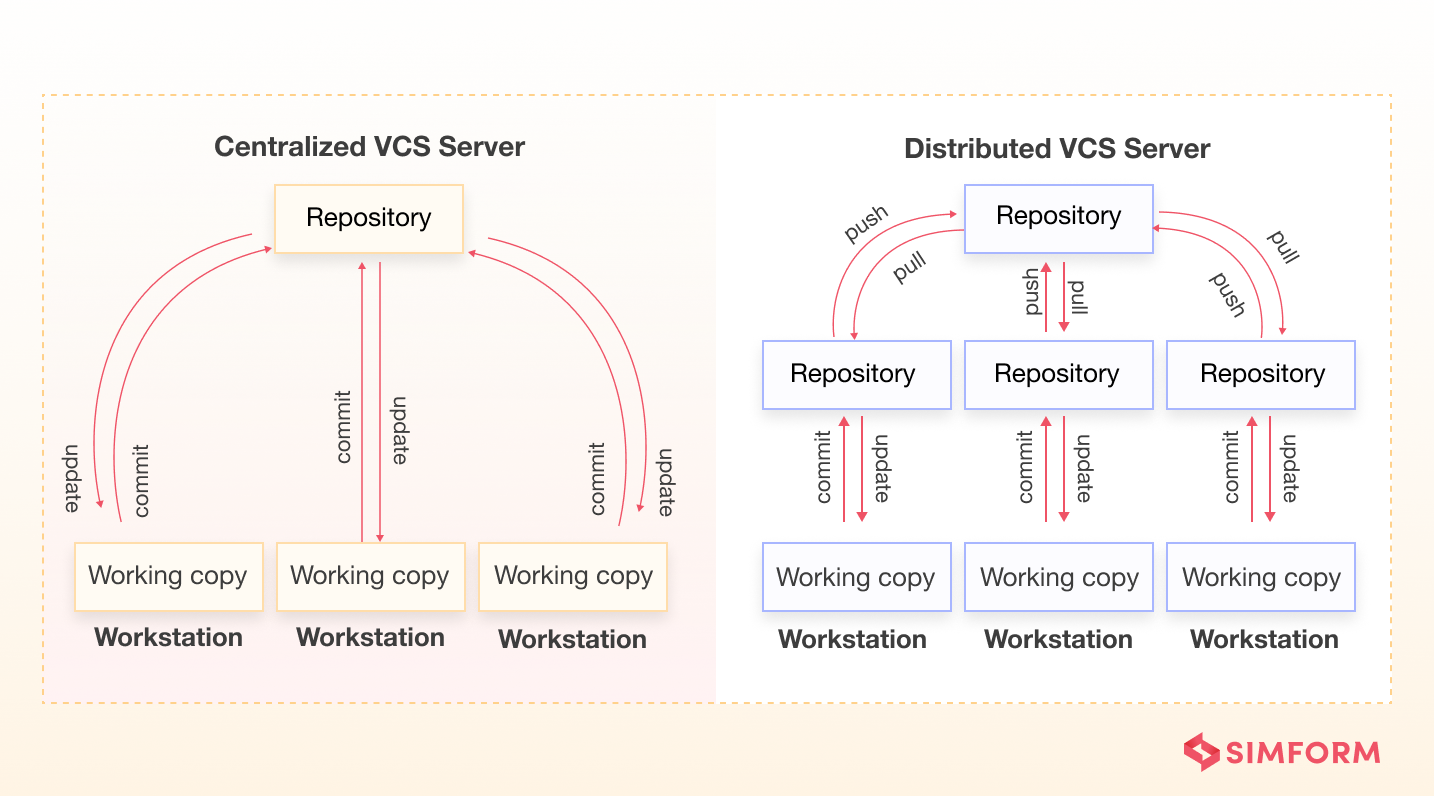
The tools employed for this stage depend mainly on the development languages and code-checking features, like vulnerability scanning, basic error detection, and adherence to established coding standards. Here are the commonly used tools –
- AWS CodeCommit
- Git (Distributed Version Control System)
- Subversion – SVN (Centralized Version Control System)
- Team Foundation Version Control – TFVC (Centralized)
Build
This stage of the CI/CD pipeline draws source code from the repository, links it to relevant libraries, dependencies, and modules, and builds an executable file. Besides building code, build automation also involves using tools to ensure code’s security and if it’s following the best CI/CD practices accordingly.
Meanwhile, tools used in the build stage also generate logs of the process, analyze the code for stylistic and programmatic errors, and notify developers about the code completion. Here are some standard tools used in the build stage:
- Jenkins
- Gradle
- Travis CI
- Azure Pipelines
Test
Now that the source code has been through static testing, the build enters the phase of dynamic testing that typically starts with the basic unit or functional testing. Then the build is subjected to various tests like regression testing, smoke testing, integration testing, compliance testing, end-to-end testing (E2E), etc., to validate its operation.
This phase lasts from seconds to hours as per the size and complexity of the project. Test specialists create highly-detailed test cases and criteria but rely on test tools. Here are some mainstream testing tools:
- Selenium (popular open-source Web UI automation testing suite)
- Appium (cross-platform)
- Jest (JavaScript testing framework)
- Playwright (cross-browser testing on complex applications)
Deploy
In a continuous delivery pipeline, the build is first sent to human stakeholders for approval, while the build automatically gets deployed after passing its test suite in a continuous deployment pipeline. In this phase, the approved code is packaged as an artifact and deployed to relevant environments, mainly to a staging environment first, then QA, and ultimately to the production environment.
This stage should be adapted to support the suitable deployment strategy, from blue-green deployments to canary deployments to in-place deployments. Deployment naturally involves additional precautions and live testing periods, including A/B tests, beta tests, blue/green tests, etc., to roll back unexpected errors and minimize the business impact. The deployment stage may involve infrastructure provisioning (Terraform), configuration (Puppet), and containerization (Docker, Kubernetes, etc.). Other popular tools include:
- Chef
- Ansible
- AWS Code Deploy
- AWS Elastic Beanstalk
- Azure Pipelines
How Etsy implemented a DevOps strategy to stay ahead of the curve
Attributes of a good CI/CD pipeline
The ultimate purpose of employing a CI/CD pipeline is to give the teams fast, reliable, accurate, and comprehensive feedback for their development cycle and let them deploy the best-quality software. Therefore, an outstanding CI/CD pipeline must have a few basic characteristics. Let’s see what they are:
Accuracy
The responsibility of modeling simple and complex workflows lies on CI/CD tools. This, in turn, removes manual errors in repetitive tasks and enables the CI/CD pipeline to run perfectly and have an accurate vision of the entire software delivery process.
Reliability
A reliable pipeline would run every time without throwing errors, eliminating developers’ frustration over increased workload on top of the compromised software quality. Self-hosted build agents offer higher flexibility but can often cause unreliable pipelines owing to maintenance issues. However, an experienced team of developers can successfully resolve the challenges and maintain reliability.
Speed
An optimized pipeline runs quickly and provides rapid feedback to the developers regarding the success or failure of the code, reducing the possibilities of distractions. Faster pipelines with lesser runtime also allow more deployments. However, the pipeline runs often result in a queued state. The solution is providing multiple agents enabling different pipelines to run in parallel. A serverless model or container orchestration dynamically scales the build agent capacity when demand is high.
How to set up a CI/CD pipeline?
#1. Understand the need for CI/CD pipeline
Fast and flexible software development requires iterative methods and frequent releases, making a CI/CD pipeline crucial. These pipelines allow development teams to work on multiple iterations simultaneously, keeping the entire team engaged throughout the development cycle.
CI/CD pipelines have become essential for modern software development teams by streamlining the development process and enabling faster, more efficient iteration.
#2. Set up version control and repository
Regarding version control systems, Git is widely regarded as one of the most popular and influential options available today. It offers flexibility in sharing and managing code, making it an excellent choice for teams collaborating on software development projects.
Here’s a step-by-step guide to choosing Git as your version control system and implementing best practices for branching and versioning:
- Choose Git as your version control system: Git provides distributed version control, allowing developers to work on their own local copies of a repository and then synchronize their changes with others. Its flexibility and scalability make it suitable for projects of any size.
- Create a repository:Create a repository to store project files and version history. Choose a Git hosting platform like GitHub, GitLab, or Bitbucket that suits your team’s needs.
- Establish a branching strategy: A branching strategy helps manage concurrent work and enables collaboration within a team effectively.
- Use feature branches: Develop new features and fix bugs in dedicated feature branches. This practice isolates work in progress from the main branch and simplifies reviewing history.
- Merge using pull requests: To ensure code quality and collaboration, adopt the practice of merging feature branches into the main branch using pull requests. Pull requests provide an opportunity for code review before merging.
- Keep the main branch up-to-date: The main branch should always reflect the stable and production-ready code. Regularly merge changes from other branches, such as feature or release branches, into the main branch to keep it up-to-date.
- Use README file: Create a README file in your repository to communicate important information about your project, including installation instructions, usage guidelines, and any additional details for contributors.
- Utilize Git Large File Storage (Git LFS): If your project involves large files, consider using Git LFS to optimize performance and manage large files effectively
#3. Define your build and test process
Determine the build tools and frameworks required for your project. Create a build script that compiles the code, resolves dependencies, and generates artifacts. Set up automated tests to validate the functionality and quality of your codebase.
#4. Choose a CI/CD platform or tool
Consider using popular CI/CD platforms like Jenkins, GitLab CI/CD, or GitHub Actions.
Evaluate the features, scalability, and integrations the platforms offer and select the one that best fits your requirements.
#5. Configure your CI/CD pipeline
Create a configuration file (e.g., .gitlab-ci.yml for GitLab CI/CD) in your repository to define the pipeline stages, jobs, and execution order. Specify the triggers for your pipeline, such as changes to specific branches or manual triggers.
- Set up automated builds:Configure your CI/CD platform to monitor your repository for changes. Define build jobs that execute the build script and generate the desired artifacts.
- Implement automated tests: Define test jobs in your pipeline configuration to execute various tests (e.g., unit tests, integration tests, and end-to-end tests). Integrate test frameworks and tools that suit your project requirements.
- Define deployment stages: Determine the environments (e.g., development, staging, production) to which you want to deploy your application. Set up deployment jobs in your pipeline to automatically deploy the artifacts to the respective environments.
- Configure notifications and alerts: Enable notifications for status updates, build/test failures, or deployment successes/failures. Set up email notifications, Slack messages, or other communication channels to keep the team informed.
- Monitor and iterate: Continuously monitor the CI/CD pipeline’s performance and stability. Collect metrics and logs to identify bottlenecks or areas for improvement. Review and refine your pipeline to optimize build times, increase test coverage, and enhance deployment.
CI/CD pipeline examples: Implement CI/CD for specific use cases
There are multiple ways and, of course, the tools to create a pipeline. Some names like Jenkins, Docker, Kubernetes, and Git might instantly come to your mind when someone says as much as CI/CD. Fortunately, you can try different combinations of tools that serve your purpose.
Scaling microservices pipelines
More and more organizations today are adopting microservices. However, microservices pipelines are different from traditional ones. And with the growing number of microservices, managing separate CI/CD pipelines for each service might quickly get out of hand.
Challenges
- If an organization uses one CI/CD pipeline per service, they’d have to support hundreds or thousands of pipelines, each connected to a separate Git repository.
- A microservice might also have multiple pipelines for internal use, production, or testing environments, which leads to even more duplication.
- Scaling of microservices naturally results in the increased requirement of network and storage. Moreover, running validation and integration testing on thousands of CI/CD pipelines can be expensive.
- Consolidating codebases with shared libraries and plugins can be quite challenging. Shared libraries generally create version-specific conflicts.
Solutions
- Containerize a pipeline to let it run independently with different language versions.
- Use one malleable pipeline for every integration and deployment. Triggers can carry information like metadata or context, enabling a pipeline to operate accordingly.
- Adopt a canary release strategy that allows new software to get released and tested among a selected subgroup of users first.
Our first example is of an application that uses microservices, containers, and the container orchestration platform.
Containerized CI/CD pipeline with automation server
With various benefits and a vast list of use cases in the cloud-native world, Kubernetes has become a natural choice for many organizations to run their CI/CD pipelines. This container orchestration tool accelerates the coding process with an intuitive user interface.
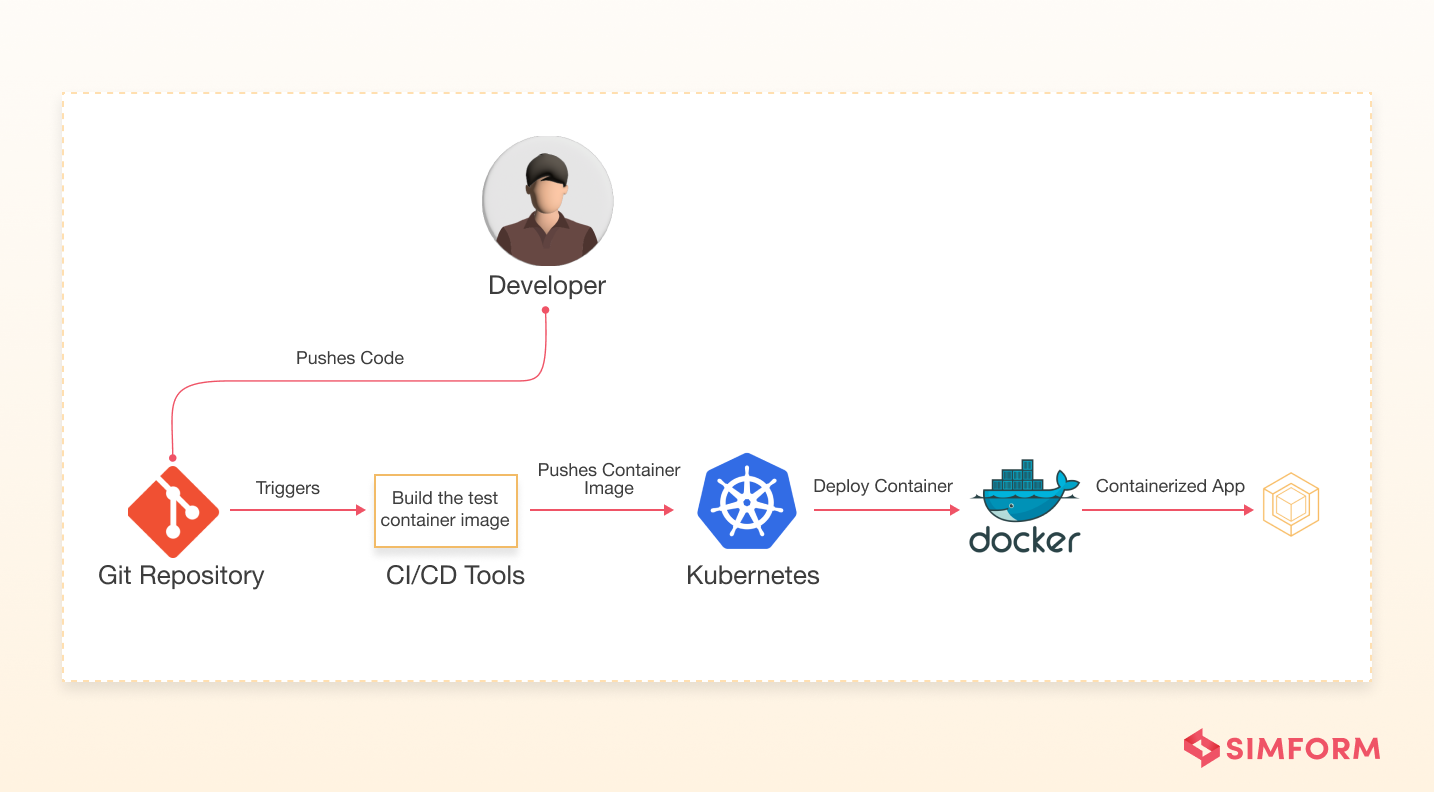
You’d need various components to deploy a standard CI/CD pipeline to the Kubernetes cluster.
- A version control system like Git is generally the first place where continuous integration begins. Multiple developers push the code changes and updates into a code repository of a VCS.
- Containerizing the software with a container such as Docker helps achieve seamless encapsulation and integration.
- An appropriate CI/CD tool like Jenkins, Travis, etc., allows you to build the docker image, run a series of tests, and push the build image to the Kubernetes cluster.
- Kubernetes helps orchestrate and deploy the container for the software build verified by the CI/CD tool.
Although a Kubernetes CI/CD pipeline streamlines deployment, monitoring, and management for microservices, you’d need to adopt good CI/CD practices to ensure security.
Serverless CI/CD pipeline for front-end
Serverless computing abstracts the infrastructure, servers, and operating systems, enabling modern developers to focus on application development. And so, building CI/CD pipelines for serverless is a bit different from that of the traditional architecture. Also, deploying and managing such applications presents a unique set of challenges.
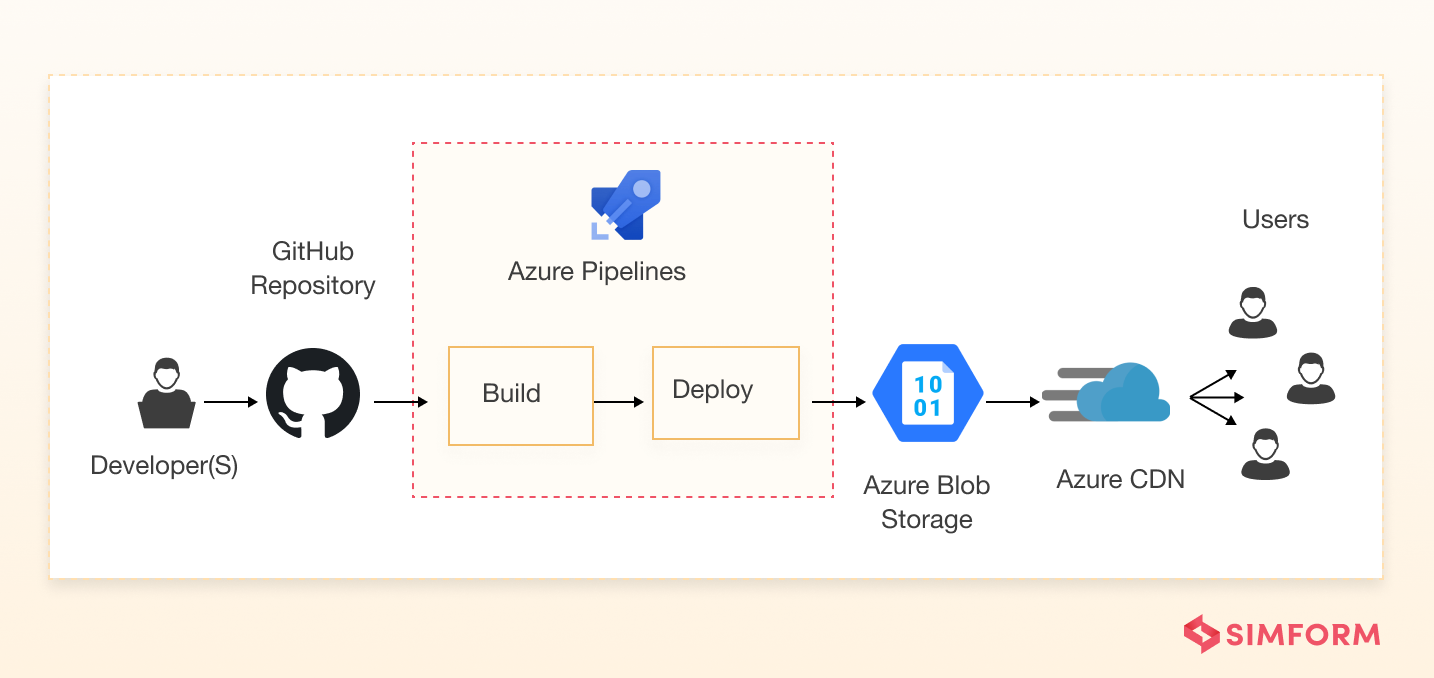
Serverless CI/CD pipeline for front-end
Above is an example of building a CI/CD pipeline with Azure services for the web front-end of a serverless application. As prerequisites for this application, you must have – a GitHub account, an Azure account, and an Azure DevOps organization.
- Keep your source code in an online version control system, which you can easily integrate with leading CI/CD services and is easier to maintain than the traditional on-premise VCS.
- The project files are kept in the GitHub repository.
- Azure pipelines let you automate the build and deploy processes. You can create various stages in the pipeline that’d run in a Windows or Linux container. And each stage will run based on the previous one’s result.
- Integrate modern build tools depending on your application’s programming language, platform, and additional functionality requirements. These tools may allow you to –
- run ad-hoc commands,
- order the execution of commands depending on dependencies,
- parallelize different commands,
- oversee file changes and run commands based on those changes,
- configure and reconfigure
- Automate the build process to reduce the human errors
- The software contents are deployed to the Blob storage (for static website hosting), which acts as the Azure CDN’s origin server. Atomic deployment ensures that the users always get the content corresponding to the same version.
- A set of distributed servers – Azure CDN accelerates the content delivery over a vast geographical area.
CI/CD pipeline with AWS
With a complete set of CI/CD tools, Amazon Web Services offers scalable, reliable, and cost-effective cloud computing services. As CodePipeline is quite simple to use, it makes more sense to use it if you are already on the AWS cloud. Moreover, it can get along easily with AWS tools and the AWS ecosystem and provide added advantages, including Amazon’s security and IAM controls.
Here’s an example of how to build a complete CI/CD pipeline with AWS Developers Tools and services.
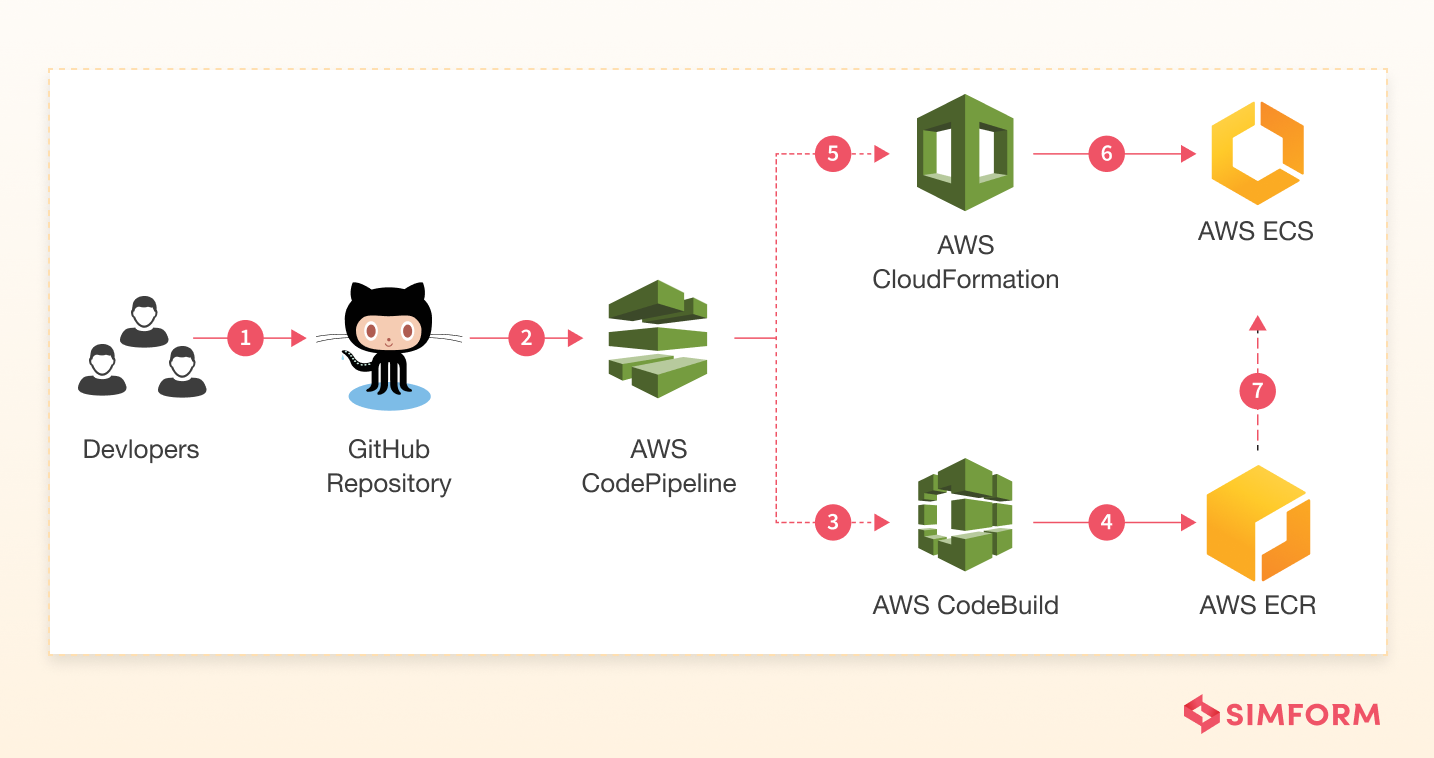
- Git repository is used in this example, but you can also use AWS CodeCommit repository or Amazon S3.
- With every code change, AWS CodePipeline automates the build, test, and deploy phase, depending on the defined release model.
- AWS CodeBuild – a fully managed CI service – compiles source code, runs tests, and packages the source code for deployment. CodeBuild scales continuously and can process multiple builds simultaneously, so the builds don’t have to wait in a queue.
- Amazon ECR is a managed container registry offering high-performance hosting, so you can reliably deploy artifacts and application images anywhere.
- AWS CloudFormation, as an infrastructure automation platform, deploys AWS resources in a recurrent, testable, and auditable manner.
- Amazon ECS, a fully managed container orchestration service, profoundly integrates with the rest of the AWS platform. So, you can easily deploy, manage, and scale containerized applications.
How did Simform help its client build a scalable CI/CD pipeline?
One of our clients wanted to build a white label software to help auction houses go digital. Their main priority was to have a scalable CI/CD pipeline that’s also secure and cost-effective. So, we
- Used a container-based pipeline, which made it easier to run different language versions independently.
- Made the pipelines unified to scale faster to deployment
- Ran tests on each push in every branch to fast-track code review
- Followed the ‘infrastructure as code’ and ‘pipeline as code’ approach
Here’s how we went about each of the stages, along with the tooling for the process.
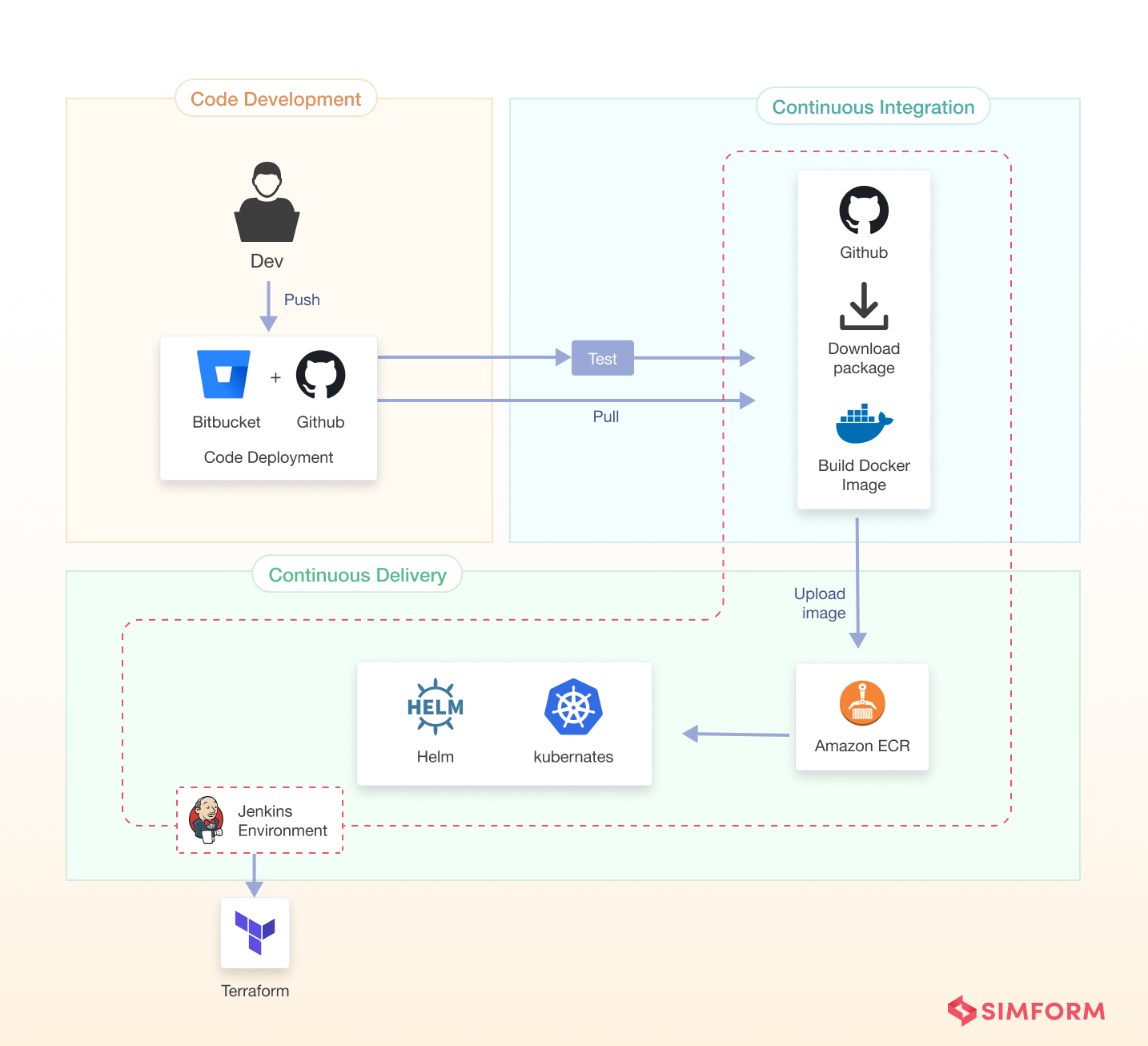
Need an expert Devops engineer for your project?
What is Simform’s approach to building scalable CI/CD pipelines?
A key aspect of implementing CI/CD pipelines is the configuration of different tests, deployments, and others for automation. Prioritizing the right tasks for automation is key to deploying CI/CD pipelines. This is where a DevOps and CI/CD implementation partner like Simform can help by offering,
- CI/CD consulting services
- CI/CD implementation services
- CI/CD pipeline auditing
- CI/CD managed services
Connect with us today to learn more about our services and start your journey toward implementing an effective CI/CD model.
